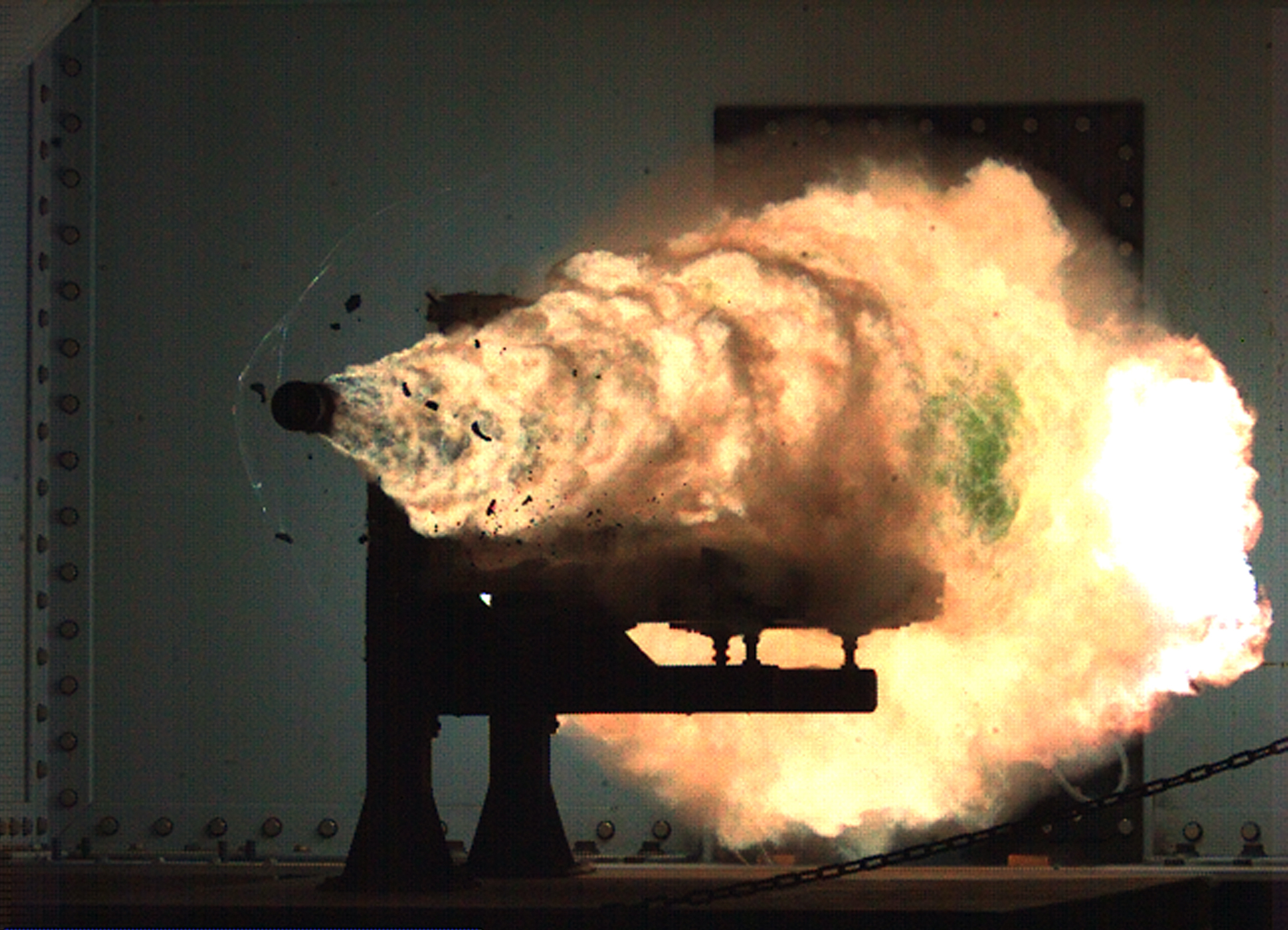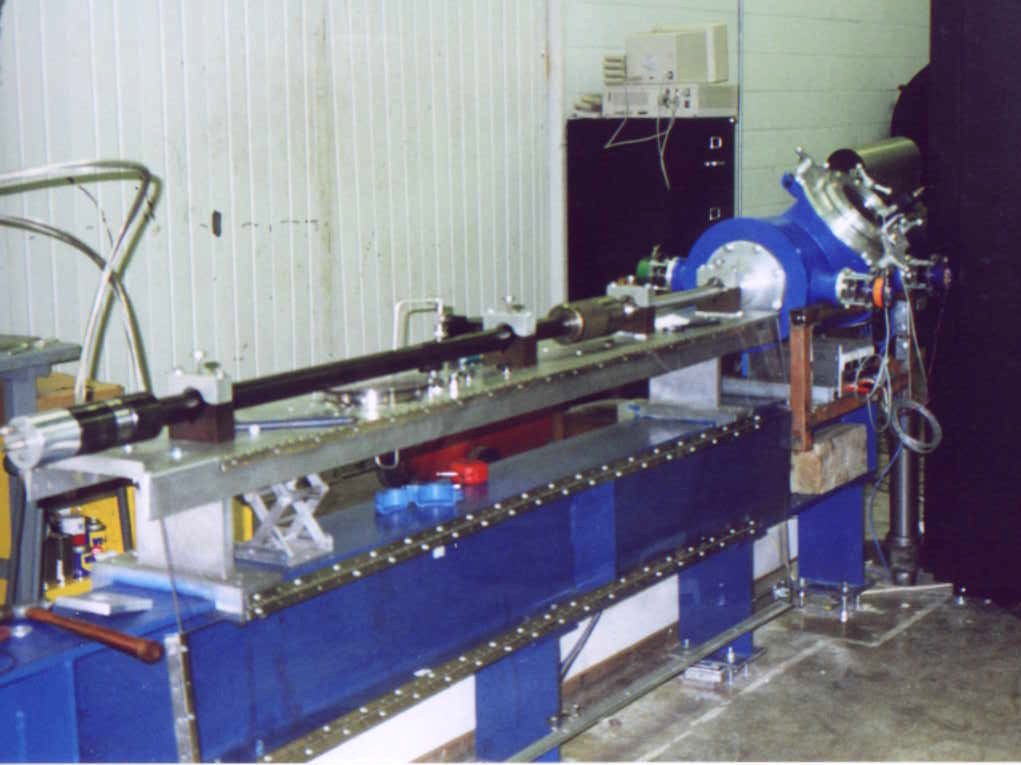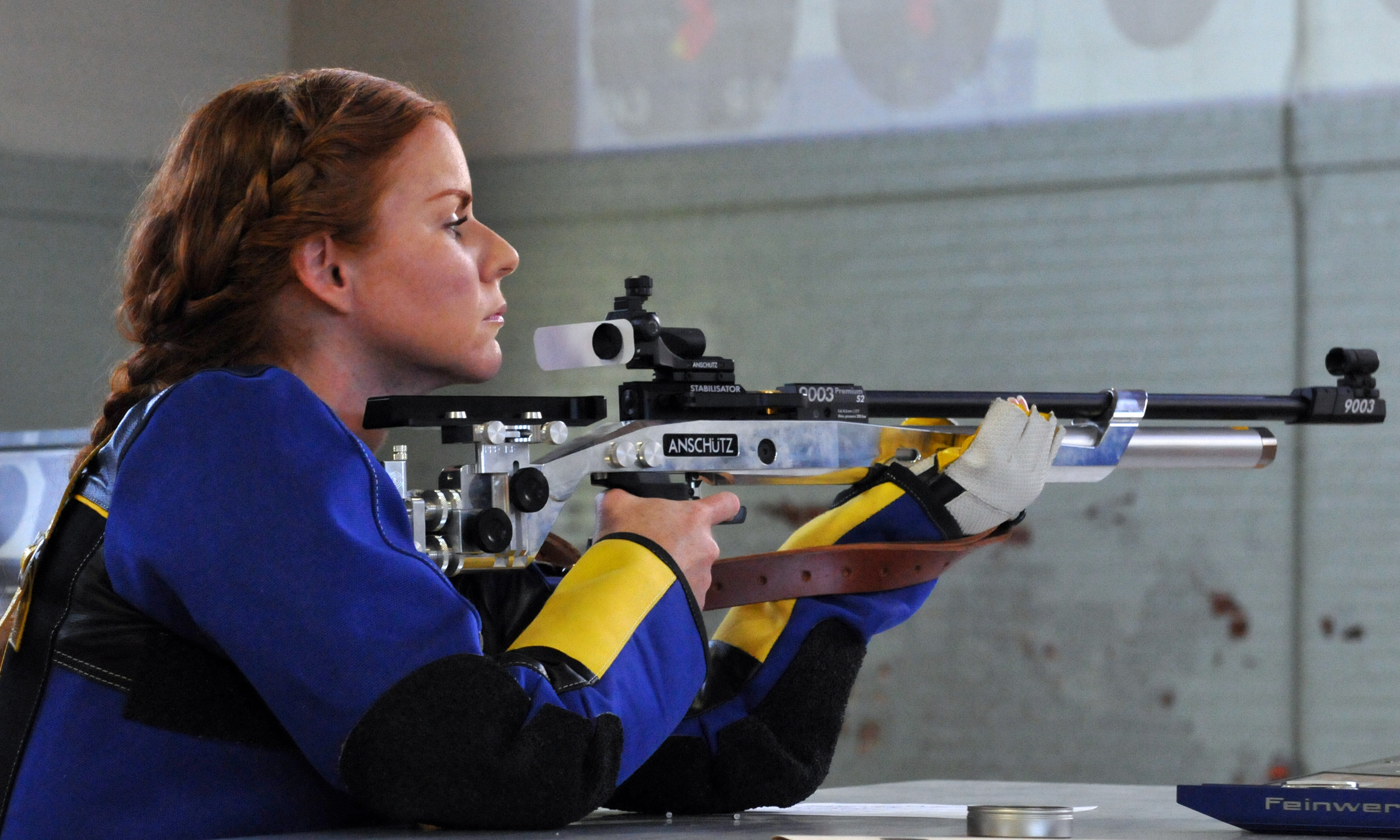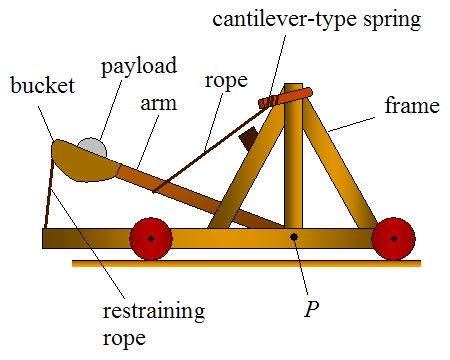|
Projectile
A projectile is an object that is propelled by the application of an external force and then moves freely under the influence of gravity and air resistance. Although any objects in motion through space are projectiles, they are commonly found in warfare and sports (for example, a thrown baseball, kicked football, fired bullet, shot arrow, stone released from catapult). In ballistics, mathematical equations of motion are used to analyze projectile trajectories through launch, flight, and impact. Motive force Blowguns and pneumatic rifles use compressed gases, while most other guns and cannons utilize expanding gases liberated by sudden chemical reactions by propellants like smokeless powder. Light-gas guns use a combination of these mechanisms. Railguns utilize electromagnetic fields to provide acceleration along the entire length of the device, greatly increasing the muzzle velocity. Some projectiles provide propulsion during flight by means of a rocket ... [...More Info...] [...Related Items...] OR: [Wikipedia] [Google] [Baidu] [Amazon] |
Railgun
A railgun or rail gun, sometimes referred to as a rail cannon, is a linear motor device, typically designed as a ranged weapon, that uses Electromagnet, electromagnetic force to launch high-velocity Projectile, projectiles. The projectile normally does not contain explosives, instead relying on the projectile's high kinetic energy to inflict damage. The railgun uses a pair of parallel rail-shaped Electrical conductor, conductors (simply called rails), along which a sliding projectile called an Armature (electrical engineering), armature is accelerated by the electromagnetic effects of a current that flows down one rail, into the armature and then back along the other rail. It is based on principles similar to those of the homopolar motor. As of 2020, railguns have been researched as weapons utilizing electromagnetic forces to impart a very high kinetic energy to a projectile (e.g. APFSDS, dart ammunition) rather than using conventional propellants. While explosive-powered milita ... [...More Info...] [...Related Items...] OR: [Wikipedia] [Google] [Baidu] [Amazon] |
Ballistics
Ballistics is the field of mechanics concerned with the launching, flight behaviour and impact effects of projectiles, especially weapon munitions such as bullets, unguided bombs, rockets and the like; the science or art of designing and accelerating projectiles so as to achieve a desired performance. A ballistic body is a free-moving body with momentum, which can be subject to forces such as those exerted by pressurized gases from a gun barrel or a propelling nozzle, normal force by rifling, and gravity and air drag during flight. A ballistic missile is a missile that is missile guidance, guided only during the relatively brief initial phase of powered flight, with the trajectory subsequently governed by the laws of classical mechanics, in contrast to (for example) a cruise missile, which is aerodynamics, aerodynamically guided in powered flight like a fixed-wing aircraft. History and prehistory The earliest known ballistic projectiles were stones, spears, and the throwing s ... [...More Info...] [...Related Items...] OR: [Wikipedia] [Google] [Baidu] [Amazon] |
Terminal Ballistics
Terminal ballistics is a sub-field of ballistics concerned with the behavior and effects of a projectile when it hits and transfers its energy to a target. This field is usually cited in forensic ballistics. Bullet design (as well as the velocity of impact) largely determines the effectiveness of penetration. General The concept of terminal ballistics can be applied to any projectile striking a target. Much of the topic specifically regards the effects of small arms fire striking live targets, and a projectile's ability to incapacitate or eliminate a target. Common factors include bullet mass, composition, velocity, and shape. Firearm projectiles Class of projectile Projectiles are primarily designed for compatibility with the constraints of the device used to launch them, and secondarily according to some balance of logistical practicality, practicable accuracy, and terminal effect. Prior to the development of rifling, the majority of projectiles purpose-built for shooting ... [...More Info...] [...Related Items...] OR: [Wikipedia] [Google] [Baidu] [Amazon] |
Bullet
A bullet is a kinetic projectile, a component of firearm ammunition that is shot from a gun barrel. They are made of a variety of materials, such as copper, lead, steel, polymer, rubber and even wax; and are made in various shapes and constructions (depending on the intended applications), including specialized functions such as hunting, target shooting, training, and combat. Bullets are often tapered, making them more aerodynamic. Bullet size is expressed by weight and diameter (referred to as "caliber") in both imperial and metric measurement systems. Bullets do not normally contain explosives but strike or damage the intended target by transferring kinetic energy upon impact and penetration. Description The term ''bullet'' is from Early French, originating as the diminutive of the word ''boulle'' (''boullet''), which means "small ball". Bullets are available singly (as in muzzle-loading and cap and ball firearms) but are more often packaged with propellant as a cartri ... [...More Info...] [...Related Items...] OR: [Wikipedia] [Google] [Baidu] [Amazon] |
Trajectory
A trajectory or flight path is the path that an object with mass in motion follows through space as a function of time. In classical mechanics, a trajectory is defined by Hamiltonian mechanics via canonical coordinates; hence, a complete trajectory is defined by position and momentum, simultaneously. The mass might be a projectile or a satellite. For example, it can be an orbit — the path of a planet, asteroid, or comet as it travels around a central mass. In control theory, a trajectory is a time-ordered set of states of a dynamical system (see e.g. Poincaré map). In discrete mathematics, a trajectory is a sequence (f^k(x))_ of values calculated by the iterated application of a mapping f to an element x of its source. Physics of trajectories A familiar example of a trajectory is the path of a projectile, such as a thrown ball or rock. In a significantly simplified model, the object moves only under the influence of a uniform gravitational force field. This can ... [...More Info...] [...Related Items...] OR: [Wikipedia] [Google] [Baidu] [Amazon] |
Light-gas Gun
The light-gas gun is an apparatus for physics experiments. It is a highly specialized gun designed to generate extremely high velocities. It is usually used to study high-speed impact phenomena ( hypervelocity research), such as the formation of impact craters by meteorites or the erosion of materials by micrometeoroids. Some basic material research relies on projectile impact to create high pressure; such systems are capable of forcing liquid hydrogen into a metallic state. Operation A light-gas gun works on the same principle as a spring piston airgun. A large-diameter piston is used to force a gaseous working fluid through a smaller-diameter barrel containing the projectile to be accelerated. This reduction in diameter acts as a lever, increasing the speed while decreasing the pressure. In an airgun, the large piston is powered by a spring or compressed air, and the working fluid is atmospheric air. In a light-gas gun, the piston is powered by a chemical reaction (usually ... [...More Info...] [...Related Items...] OR: [Wikipedia] [Google] [Baidu] [Amazon] |
Muzzle Velocity
Muzzle velocity is the speed of a projectile (bullet, pellet, slug, ball/ shots or shell) with respect to the muzzle at the moment it leaves the end of a gun's barrel (i.e. the muzzle). Firearm muzzle velocities range from approximately to in black powder muskets, to more than in modern rifles with high-velocity cartridges such as the .220 Swift and .204 Ruger, all the way to for tank guns firing kinetic energy penetrator ammunition. To simulate orbital debris impacts on spacecraft, NASA launches projectiles through light-gas guns at speeds up to . Several factors, including the type of firearm, the cartridge, and the barrel length, determine the bullet's muzzle velocity. Projectile velocity For projectiles in unpowered flight, its velocity is highest at leaving the muzzle and drops off steadily because of air resistance. Projectiles traveling less than the speed of sound (about in dry air at sea level) are ''subsonic'', while those traveling faster are ''super ... [...More Info...] [...Related Items...] OR: [Wikipedia] [Google] [Baidu] [Amazon] |
Pneumatic Rifle
An air gun or airgun is a gun that uses energy from compressed air or other gases that are mechanically pressurized and then released to propel and accelerate projectiles, similar to the principle of the primitive blowgun. This is in contrast to a firearm, which shoots projectiles using energy generated via exothermic combustion (detonation) of chemical propellants, most often black powder or smokeless powder. Air guns come in both long gun (air rifle) and handgun (air pistol) forms. Both types typically propel metallic projectiles that are either diabolo-shaped pellets or spherical shots called BBs, although in recent years Minié ball-shaped cylindro-conoidal projectiles called slugs are gaining more popularity. Certain types of air guns (usually air rifles) may also launch fin-stabilized projectile such as darts (e.g., tranquilizer guns) or hollow-shaft arrows (so-called "airbows"). The first air guns were developed as early as the 16th century, and have since bee ... [...More Info...] [...Related Items...] OR: [Wikipedia] [Google] [Baidu] [Amazon] |
Cannon
A cannon is a large-caliber gun classified as a type of artillery, which usually launches a projectile using explosive chemical propellant. Gunpowder ("black powder") was the primary propellant before the invention of smokeless powder during the late 19th century. Cannons vary in gauge (firearms), gauge, effective range, mobility (military), mobility, rate of fire, elevation (ballistics), angle of fire and firepower; different forms of cannon combine and balance these attributes in varying degrees, depending on their intended use on the battlefield. A cannon is a type of heavy artillery weapon. The word ''cannon'' is derived from several languages, in which the original definition can usually be translated as ''tube'', ''cane'', or ''reed''. The earliest known depiction of cannons may have appeared in Science and technology of the Song dynasty#Gunpowder warfare, Song dynasty China as early as the 12th century; however, solid archaeological and documentary evidence of cannons do ... [...More Info...] [...Related Items...] OR: [Wikipedia] [Google] [Baidu] [Amazon] |
Catapult
A catapult is a ballistics, ballistic device used to launch a projectile at a great distance without the aid of gunpowder or other propellants – particularly various types of ancient and medieval siege engines. A catapult uses the sudden release of stored potential energy to propel its payload. Most convert Tension (mechanics), tension or Torsion (mechanics), torsion energy that was more slowly and manually built up within the device before release, via springs, bows, twisted rope, elastic, or any of numerous other materials and mechanisms which allow the catapult to launch a projectile such as rocks, cannon balls, or debris. During wars in the ancient times, the catapult was usually known to be the strongest heavy weaponry. In modern times the term can apply to devices ranging from a simple hand-held implement (also called a "slingshot") to a mechanism for Aircraft catapult, launching aircraft from a ship. The earliest catapults date to at least the 7th century BC, with Kin ... [...More Info...] [...Related Items...] OR: [Wikipedia] [Google] [Baidu] [Amazon] |
Smokeless Powder
Finnish smokeless powder Smokeless powder is a type of propellant used in firearms and artillery that produces less smoke and less fouling when fired compared to black powder. Because of their similar use, both the original black powder formulation and the smokeless propellant which replaced it are commonly described as gunpowder. The combustion products of smokeless powder are mainly gaseous, compared to around 55% solid products (mostly potassium carbonate, potassium sulfate, and potassium sulfide) for black powder. In addition, smokeless powder does not leave the thick, heavy fouling of hygroscopic material associated with black powder that causes rusting of the barrel. Despite its name, smokeless powder is not completely free of smoke; while there may be little noticeable smoke from small-arms ammunition, smoke from artillery fire can be substantial. Invented in 1884 by Paul Vieille, the most common formulations are based on nitrocellulose, but the term was also used to ... [...More Info...] [...Related Items...] OR: [Wikipedia] [Google] [Baidu] [Amazon] |
Equations Of Motion
In physics, equations of motion are equations that describe the behavior of a physical system in terms of its motion as a function of time. More specifically, the equations of motion describe the behavior of a physical system as a set of mathematical functions in terms of dynamic variables. These variables are usually spatial coordinates and time, but may include momentum components. The most general choice are generalized coordinates which can be any convenient variables characteristic of the physical system. The functions are defined in a Euclidean space in classical mechanics, but are replaced by curved spaces in relativity. If the dynamics of a system is known, the equations are the solutions for the differential equations describing the motion of the dynamics. Types There are two main descriptions of motion: dynamics and kinematics. Dynamics is general, since the momenta, forces and energy of the particles are taken into account. In this instance, sometimes the term ... [...More Info...] [...Related Items...] OR: [Wikipedia] [Google] [Baidu] [Amazon] |








